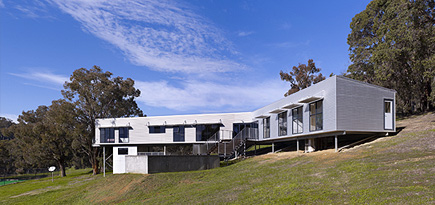
BLUESCOPE STEEL REMAINS COMMITTED TO REDUCING THE GREENHOUSE GAS INTENSITY OF OUR OPERATIONS, CONTINUOUSLY IMPROVING OUR ENVIRONMENTAL FOOTPRINT AND CONTRIBUTING TO GREENHOUSE GAS ABATEMENT AND CLIMATE CHANGE ADAPTATION THROUGH THE INNOVATIVE USE OF OUR PRODUCTS.
Steel products will play an integral role in reducing society’s greenhouse gas emissions. Steel is critical to the development of clean energy infrastructure. For example, a typical wind turbine relies on more than 200 tonnes of iron and steel in its manufacture. Many of a wind turbine’s structural components are made of steel plate, such as BlueScope Steel’s XLERPLATE®, and cannot be economically built with alternative materials.
Steel is also an essential material in solar generation, in more energy efficient buildings, in public transport infrastructure, and in lighter weight, hybrid and electric cars.
Adaptation to climate change in our homes and businesses will require innovative products such as BlueScope’s COLORBOND® Coolmax® coated steel roofing. A roof made from COLORBOND® Coolmax® could help reduce the annual cooling energy costs of buildings by up to 7.5% by maximising the thermal performance of the building. Using COLORBOND® Coolmax® rather than other lower solar reflectance roofing materials may also help mitigate the Urban Heat Island (UHI) effect. Elevated temperatures from UHI, particularly during summer, can affect a community’s environment and quality of life. According to the US Environmental Protection Agency , the effects of UHI include increased energy consumption, elevated emissions of air pollutants and greenhouse gases, and impaired water quality.
BlueScope Steel remains committed to progressively reducing its emissions, and continues to play an active role in the global steel industry’s efforts to reduce greenhouse gas emissions.
The steel industry faces some unique challenges as the world moves towards a lower carbon global economy. Making iron and steel produces significant quantities of greenhouse gases. In an integrated steelworks, carbon, in the form of coal and coke, is the reducing agent used to convert iron ore to iron in a blast furnace. Carbon dioxide and other greenhouse gases are emitted as an unavoidable by-product of this process.
The laws of chemistry, physics and thermodynamics dictate the amount of carbon used in the blast furnace, with current usage close to theoretical minimum levels. Any significant reduction in direct emissions will therefore require a major technology breakthrough.
The global response to climate change is expected to involve numerous new clean energy technologies. Many of these, such as wind, wave and tidal power, carbon capture and storage, are steel intensive.
BlueScope Steel, in partnership with other steel makers and the World Steel Association (worldsteel), representing approximately 80 per cent of the world’s steelmakers, is contributing to worldwide data collection and research efforts
BlueScope Steel is engaged in two research projects under the worldsteel CO2 Breakthrough Programme. The first project focuses on the potential to use a proportion of biomass as a substitute for coal or natural gas, in the iron and steelmaking process.
The second project aims to recover and reuse waste heat energy collected in a dry slag granulation process. The new process also has the potential to save fresh water.
BlueScope Steel is also recognised, under the worldsteel Climate Action recognition program, for its participation in the industry’s greenhouse gas data collection program.

